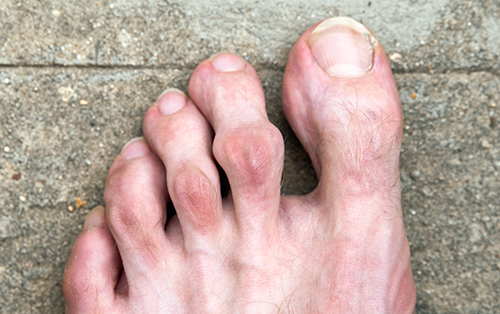What causes hammertoes and corns?
Miscellaneous
St. Joseph’s/Candler Podiatrist Dr. Prianka Sharma discusses causes, treatment and preventing these two common foot deformities
It’s that time of year again, when we break out sandals or flip flops to go to the beach or run a quick errand. (Although honestly in the South we can do that almost year around.) However, if you have an issue with your feet or toes, whether painful and/or cosmetic, you may be hesitant to do so.

Two frequent conditions St. Joseph’s/Candler Podiatrist Dr. Prianka Sharma treats are hammertoes and corns. You may be familiar with them, as common as they are, but let’s take a closer look at causes, treating and preventing.
Hammertoes
A hammertoe is when the toe bends or curls downward. This causes the proximal joint of the affected toe to protrude or poke up. There are different types of hammertoes as well, Dr. Sharma explains. A hammertoe is the contracture of the proximal joint, the one closer to the base of the foot. A mallet toe is a contracture of the distal joint, or bending at the tip of the toe. Then there’s a claw toe, which is a combination of both, Dr. Sharma explains.
Causes: Most commonly people think hammertoes are automatically caused by shoes, and sometimes they are, Dr. Sharma says. However, more commonly hammertoes are hereditary and passed down from our parents. Hammertoes also can be caused due to a tendon imbalance within the joints. There are opposing tendons per toe that are responsible for flexion and extension, Dr. Sharma explains. When the flexor tendon overpowers the extensor tendon, it can form hammering of the toe.

Treating: Not every hammertoe needs surgery, Dr. Sharma says. Conservative treatment is available if you wish not to have surgery; however, the hammertoe can reoccur. If you opted for surgery, it must first be determined if the hammertoe is flexible or rigid. Rigid hammertoes typically are arthritic and will require a more invasive procedure. If that’s the case, one of the best options is an arthrodesis procedure, or fusing the joint, Dr. Sharma says. This is the surgical removal of cartilage on either side of the toe, and using pins to properly position the joint for fusion. The pin is removed four to six weeks later, depending on X-ray results that the joint is fused in place. The benefit of fusing the joint is there is less recurrence, Dr. Sharma says.
If it’s a flexible hammertoe, there are a couple of additional options. One is a flexor tenotomy, which releases the flexor tendon underneath the toe and allows that toe to straighten. Another treatment is called arthroplasty, which is the removal of only one side of the joint so you can straighten the toe without fusion or pins. However, with these options, the hammertoe may return. Dr. Sharma says nine times out of 10, she’s fusing the joint for hammertoe repair to prevent recurrence.
Corns
Corns are calluses that form on or in between the toes, quite frequently accompanying hammertoes. Calluses (which form on the plantar surface of the foot) and corns are thickened areas of skin caused by friction or pressure, forming on the dorsal surface of the foot. Your body makes this callus tissue so you have a barrier between your skin and the bone, Dr. Sharma says. “They are both extra tissue that your body has formed to create like a band aid to help prevent breakdown of soft tissue.”

Causes: Corns are caused by rubbing, friction or pressure applied to the toes. This can be from shoes that don’t fit well, foot bones that are not in the normal position or a lot of physical activity, such as daily running. Honestly, Dr. Sharma says, if we didn’t wear shoes, we wouldn’t get corns. However, going barefoot can lead to other problems with our feet, so it’s best to wear proper shoe gear based on your activity.
Treating: The conservative way to treat corns is shaving it down and follow up with routine care, Dr. Sharma says. This is especially important for people with diabetes so the corn doesn’t lead to an ulcer or infection, which if ignored or unrecognized, can lead to amputation. There are over-the-counter pads available to shield the corn from rubbing; however, Dr. Sharma warns against these as many contain salicylic acid which can worsen the problem. She recommends a prescription cream for her patients to apply to the area in between shavings. Shaving is not a cure-all, as the corn may return, unless you surgically fix the problem. Surgery could involve shaving down the bone, repositioning or, as mentioned above, fusing the joints. In some cases, tendons or ligaments may be cut to reduce tension on a bone or joint.
Preventing hammertoes and corns: If it’s a hereditary issue, especially paired with the biomechanics of your foot, it may be out of your control. You can always adjust your shoe gear. Make sure you are wearing appropriate shoes for appropriate activities. We understand that you are most likely going to wear flip flops to the beach. A trip to the grocery store or walking the dog, especially if it’s longer than 30 minutes, Dr. Sharma says to wear tennis shoes. She also advises you to look not just at the width of your shoes, but the height of the toe box.
“Turn your shoe to the side and see how high your shoe box is. If it’s really narrow in the toe, it doesn’t matter how wide that shoe is, you’re still going to get corns. Make sure you actually have room for your toes to move and breathe.”
Another common foot problem? Bunions. Dr. Sharma discusses bunions in this article.